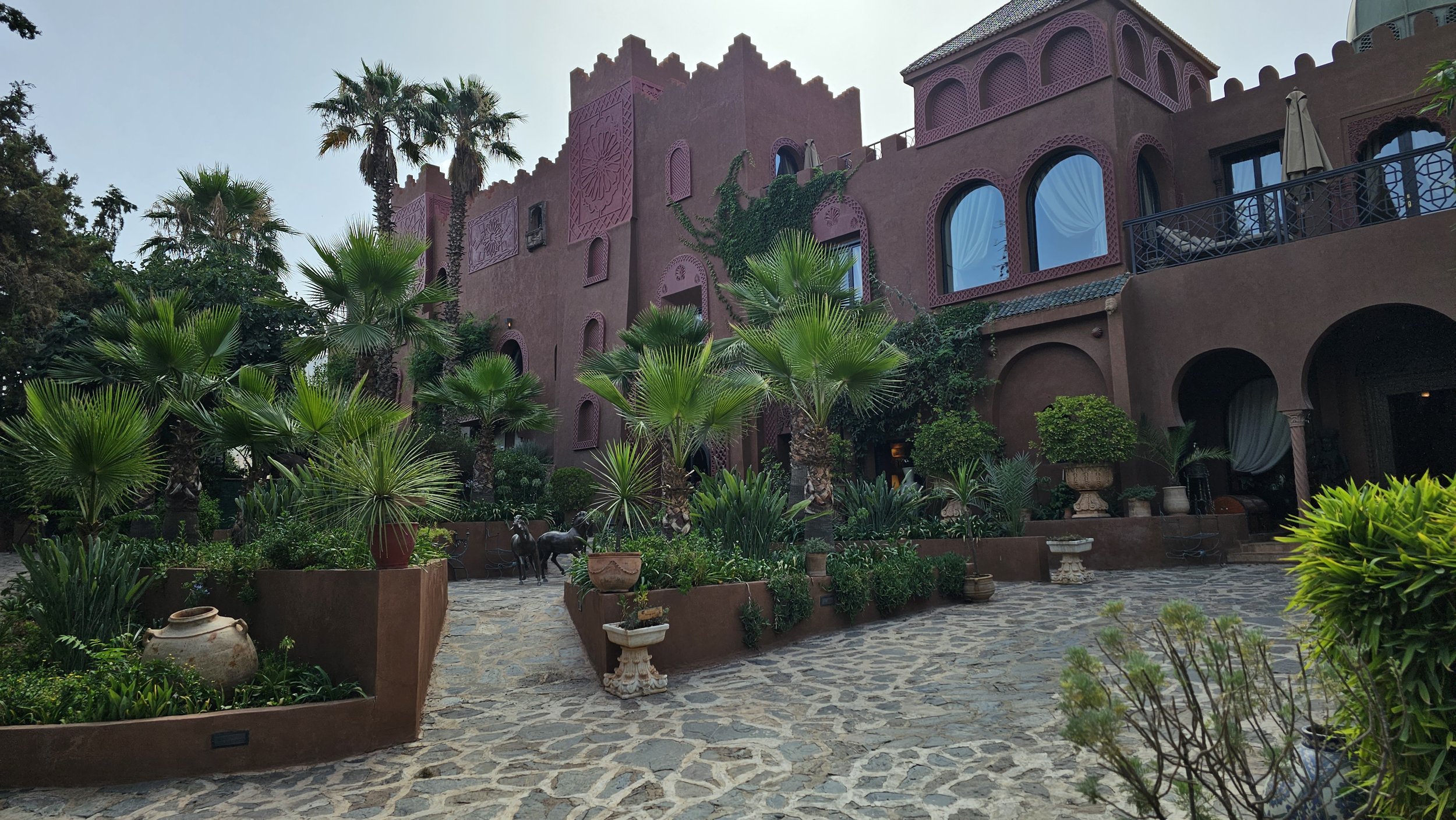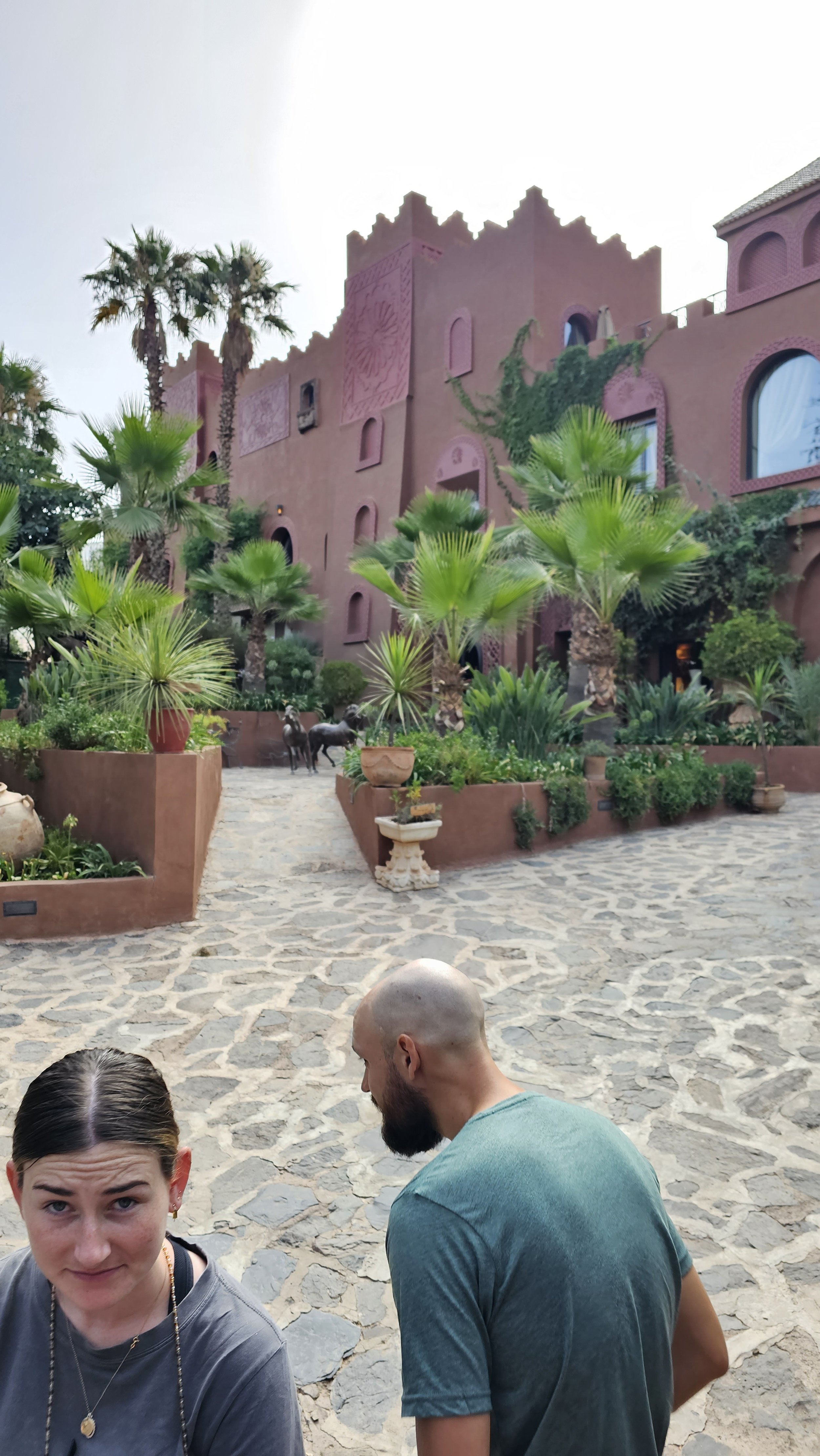Morocco - part 2 of 3
يله مغربي
Yellah Morocco
Let’s go Morocco
Day 10
We left Marrakech at 9am and took a short drive into the High Atlas Mountains to the village of Imlil. We stored our luggage in the hotel, packed an overnight bag onto mules and started our walk towards the peaceful village of Aroumd. Along a way we saw many walnut, apple and cherries trees full of fruit. This village is 400 years old, perched on a rocky outcrop and offers stunning views of the High Atlas Mountains. It is a special place to explore beyond the reach of the modern world.
I didn’t know there are as high mountains in Morocco perfect for hiking and tracking in spring or autumn time, and ski fields in the winter time, with heaters in the hotel bedrooms for cold winters, believe it or not?!
The mountain summit is 4167m above the sea level!
I thought Morocco was pretty much a desert country while actually Sahara Desert sand dunes make up 20% of Moroccan landmass, the rest of the Sahara desert is rocky mass or dried out lakes, everywhere else is green with huge Atlas Mountains chain spreading across the country. What a surprise!
The visit to Aroumd gave us an opportunity to experience a true Amazigh culture. Since Amazigh people are the indigenous people of Atlas Mountains, it was sooo cool! Lachen our new tour guide is another proud Amazigh!
12 families who live in Aroumd make up 2000 people who live as one community supporting one another in everything.
They have a mosque, Hamam and a school all built together as a community with no help from the government. After waiting for 50 years they simply took charge of their own destiny and went on with it!
Intrepid Tours collects the money and puts it towards the girls education and builds homes and colleges in villages within the Atlas Mountains, 5 are built so far and more to come. I loved this fact, it’s good to know a portion of our money goes for a good cause. I’d say good on them!
We spent a night in a family run mountain gite and enjoyed the hospitality of wooden baked bread, tangine or tajine, Moroccan whisky ( green and mint tea) and amazing peanuts cookies, yummy!
Early morning after breakfast we went hiking for 8km return to the pilgrimage shrine of Sidi Chamharouch!
We have never ever done anything like this and I am super proud of us both!
We hiked uphill on uneven surfaces in hot weather for over 4 hours, and went all the way up the mountain to see the shrine.
We walked from 1930m to 2350m above sea level! We had a freshly squeezed cold orange juice on the way up, saw many mules carrying people and goods, enjoyed the beauty of the nature all along.
Although the shrine is a holly place it carries a pretty bad reputation! The story goes like this: women come to either find a husband or those whose are married to get pregnant. Quran says you believe only in one God, when women start believing in shrine superpowers the troubles start, marriages split, betraying starts, and you can get the rest of the story, not good!
I found it fascinating we got told a completely different story by the local tour guide to what the itinerary stated about the shrine! That’s the best part of having local people guiding you on tours, so much more information and fun!
This day’s memory will last forever! We’ve never done anything like this before, we had sunshine, thunderstorms and refreshing walk back downhill with a bit of rain! Yes the very first rain since we started our journey that lasted 15mins!
On arrival we had delicious home made dinner and slept like the babies!
Photo Album Imlil/Aroumd
…walking towards pilgrimage shrine, at this point we were about 1,980 meters above sea level
… coming back to Imlil after the day walk


















Day 11
After breakfast we walked back to Imlil village to pick up our bags and we continued journey along the mountain roads and over Morocco’s highest pass Tizi n’Tichka (2260m) to Ait Benhaddou, one of the Morocco’s most iconic sites.
On the way we stopped by Richard Benson’s hotel full of people who pay fortune to stay in this beautiful hotel, who would have ever thought he’d own a hotel in Morocco?!
Ait Benhaddou village hasn’t changed since the 11th century although the local tour guide believes it’s even older because of the architecture and exposed external beauty of the buildings built out of terracotta soil, straws and water! And they are still standing strong and proud!
Between the old and a new village there is a river and donkeys are used to carry people and stuff over. But no river today! Drought is so prominent, they have never experienced it as bad, so we simply walked across the river bed to get to the old village.
After 1956 the first family moved from the old to the new village, the year when Morocco declared its independence. Today there are only 8 families who live in the old village.
It used to be a caravan stop for salt trading. In the old days salt and gold had the same value / price and the river is called the Salt River, it was a golden time for the community.
But guess what?! It is a very important site today too, not because of the salt but for the movies production! Yes, this is the site where Gladiator (both movies) were shot, plus Game of Thrones, including our very own tour guide acting in the Season 4 episode 6! We are all now going to rewatch that episode to spot our Mohamed. 🤗
Since 1987 this village has become UNESCO protected site. Since then, if a movie studio builds anything, they need to destroy it after the production is over to keep the site in its original state. A great call!
Mohamed took us to the old village to show us his family home. It’s mind blowing how they make living out of so little and how strong is the community co-life.
Even animals live inside the house area because the land is individually owned so they respect it and don’t want animals to randomly wonder around and eat each other grass. It’s organised farming with pre agreed protocols. We could learn a lot from these people!
Only 10 years ago they’ve got a fresh water in houses. There are many olive trees, and they make a well known extra virgin olive oil out of green olives.
Bread is made every second day, it is a shared responsibility, it means less work and less wood needed to bake it when they work as a community rather than individually. Super cool if you ask me!
Couscous takes 3 hours to make, yes and not 3 minutes! First you stew the meat with onion and water, later you add veggies, and couscous comes last, you must only steam couscous, never cover it with boiled water!
They have a mosque and a synagogue.
Jews and Muslim lived here together for 600 years. In 1947 most Jews went to Israel after the country was formed, and in 1964 the last Jew family left to Jerusalem.
When I asked why today co-life is almost an impossible concept, Mohamed’s response was: it’s never been about religion, it’s always about the money, power, politics and crazy people! I couldn’t agree more!
We stopped by Tawesna Teahouse on the banks of the river. This community run establishment provides local women with income to support their families, who in turn produce delicious pastries, cookies and tea using locally produced ingredients.
Photo Album Richard Benson’s hotel


Photo Album Ait Benhaddou

























Day 12
We left after breakfast and went south towards Sahara.
We visited a nice local carpet “factory” where ladies work in their spare time. The variety is phenomenal, all hand made, individually designed and unique. We bought a small rug for Jahorina, couldn’t resist to do it and are so happy we did it as 80% of the carpet price goes to the lady who made it! They only use natural ingredients for dying: white, grey and black are natural colours, green tea is used to get a green colour, saffron and pomegranate produce red and yellow depending on a ratio, and of course indigo gives the blue colour. Natural and organic rug is off to Jahorina!!!
After the carpet place, we drove by the biggest solar power pole in the world, shaped like giant cobra snake, and arrived to The Atlas Movie Studio, the third biggest cinematic studio in the world and the biggest in Africa in Ourarzazate. I had no idea this massive place existed in Morocco! You see how many cool, interesting and new things we uncovered in this trip. Morocco is amazing and had a lot more to offer than a desert and camels!
A few fun facts about the movies screened here:
Jewels of Niles was the first movie
Gladiator
James Bond
Prison Break series
Aladdin
Ben-Hur etc..
Passion of the Christ - Directed here but banned in many European countries due to Jesus relationship with Marija Magdalena.
7 years in Tibet with Brad Pitt - represents Tibet as an independent country and was banned in China. Atlas Mountains were used to represent Tibet.
Versace commercial screened here !
Netflix Cleopatra new series is being screened right now and we shot a video on the actual site - you’d love it!
… from Netflix’s new series Cleopatra set
…from Alladin movie set
Photo Album The Atlas Movie Studio


They use wood and plaster to build the scenes, everything is fake but looks so real!
Some scenes are reused for different movies, economy of scale!
We left the Atlas Studio with tens of photos and videos, loved it!
Our journey continued and we arrived around 4.30pm to Zagora, the last township before the Sahara desert. It felt we were entering a ghost town, no one was out, town was literally empty because it was deadly hot!
We settled into our hotel and jumped into the pool to refresh before the palm trees oasis walk and a dinner.
Palm trees walk was superb, all trees are Date Palm trees and they grow over 23 varieties, with October being the harvest month when the top quality dates are sold for 200 dirham per 1kg. (20 Euros). On average each palm tree produces around 260kg dates! And they come in different levels of sweetness.
Irrigation systems are in place to water palm trees and veggies and sometimes have to go 35 to 65m deep to find the water! The working conditions and ingenuity of these people continues to fascinate me each day!
Photo Album Zagora






























































